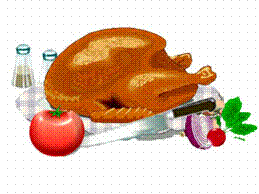
Sign My Guestbook
View My Guestbook

The Crew of the Upoars loves Email
upoars@erols.com

Q: Is it best to cook the stuffing inside the bird, or separately in a baking dish?
A: Many chefs today recommend cooking the stuffing in a separate dish instead of in the cavity. When placed inside the bird, stuffing cooks unevenly and may not be completely cooked through, offering a potential health hazard. Also, an unstuffed bird requires less cooking time, leaving the breast meat moister. Baked separately, a stuffing should initially be cooked covered for 45 minutes, and if the interior is too dry, simply moisten with some of the pan juices. Then uncover for a final 20-30 minutes of cooking to develop a wonderful crackly top.
Q: If I do want to stuff the bird, what's the best way to do it?
In the traditional method, gently place the stuffing in the body and neck cavities but be sure to pack them loosely. As it cooks, the stuffing will expand. You also want the stuffing to cook through completely, and hard packed stuffing may not.
A newer method places the stuffing between the meat and the skin. Loosen the skin over the breast, legs and thighs and gently insert the stuffing. This results in a very moist bird and ensures the stuffing to cook through. If there is any leftover stuffing, bake it separately in a baking dish.
Turkey Tip: To save time, make your stuffing in advance and freeze it, then thaw overnight in the refrigerator. If you plan to use the gizzards, then remove them from the bird just before roasting and cook and stir them into your pre-made stuffing.
Q: How much stuffing do I need?
A: If you just want to stuff the cavity, then allow 1/2 cup stuffing per pound of turkey. If you want extra stuffing and plan to bake it separately, then allow 1 cup of stuffing per pound, and even more if it's a perennial favorite. While stuffings can be made from all different types of breads, grains and rice, here's a handy rule-of-thumb to follow: plan on using a single slice of bread to make 1/2 cup of stuffing when mixed with added seasonings and aromatics.
Q: Do I need to close up the cavity after it has been stuffed?
A: Some cooks like to skewer or sew the cavity shut after stuffing but it's not at all necessary and is entirely up to the cook.


The Crew of the Upoars loves Email
upoars@erols.com